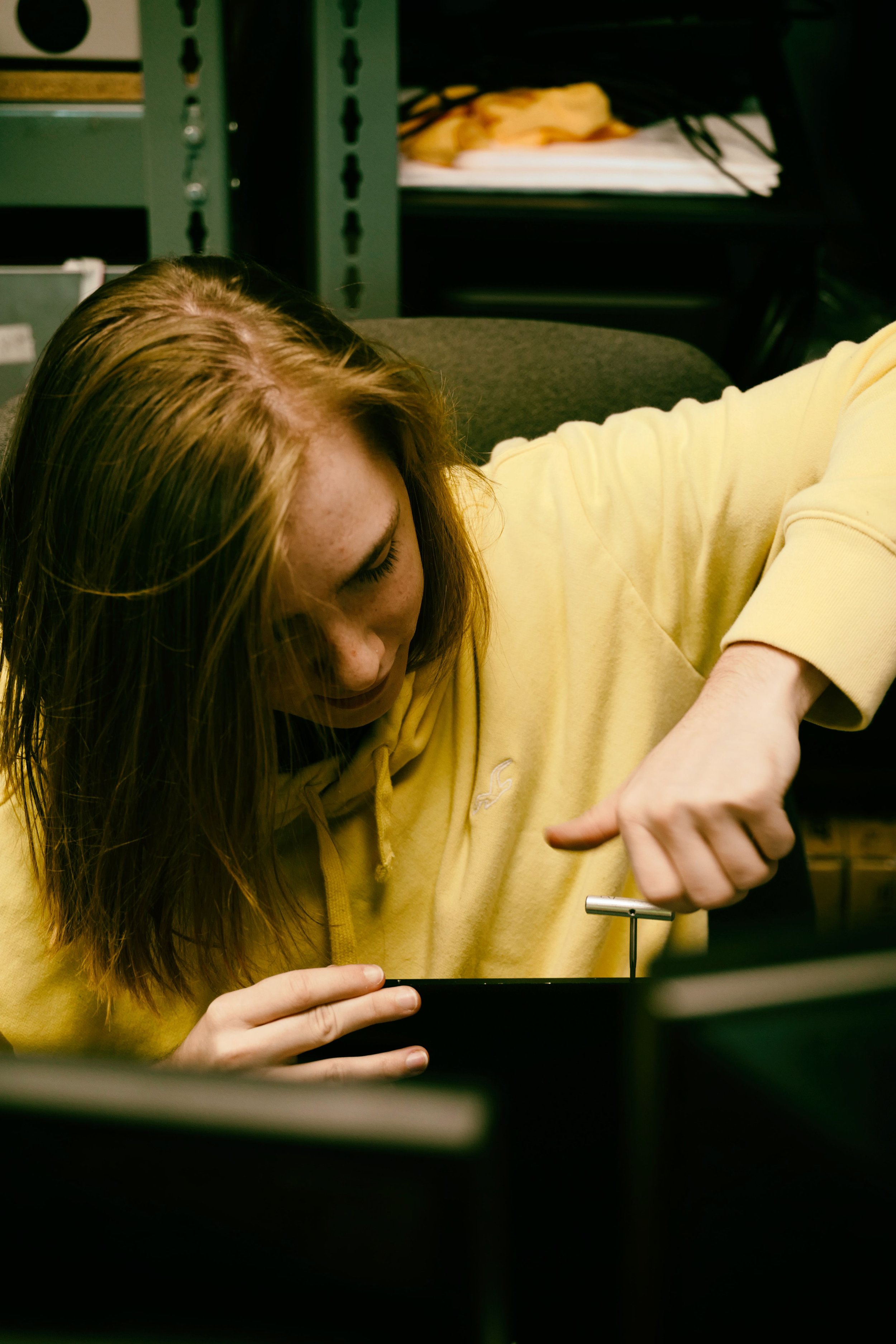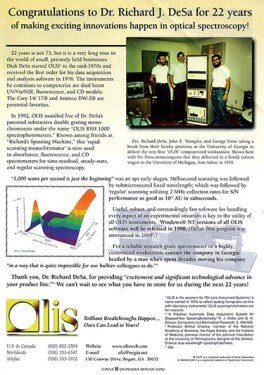Getting The Uv/vis To Work
Getting The Uv/vis To Work
Blog Article
8 Simple Techniques For Uv/vis/nir
Table of ContentsFascination About Circular DichroismUv/vis Can Be Fun For AnyoneThe Ultimate Guide To Uv/visAn Unbiased View of SpectrophotometersNot known Incorrect Statements About Circularly Polarized Luminescence The Best Guide To Circular DichroismGetting The Uv/vis/nir To WorkThe Best Strategy To Use For Uv/vis/nirHow Spectrophotometers can Save You Time, Stress, and Money.Uv/vis Fundamentals ExplainedThe Ultimate Guide To Uv/vis/nirSpectrophotometers Things To Know Before You Get ThisFacts About Spectrophotometers Uncovered
It is then scanned through the sample and the reference options. Fractions of the occurrence wavelengths are sent through, or reflected from, the sample and the recommendation. Electronic circuits convert the relative currents into linear transmission percentages and/or absorbance/concentration values.The transmission of a referral compound is set as a standard (information) worth, so the transmission of all other substances are taped relative to the initial "zeroed" substance. The spectrophotometer then converts the transmission ratio into 'absorbency', the concentration of specific parts of the test sample relative to the preliminary substance.
Because samples in these applications are not readily offered in large amounts, they are specifically suited to being analyzed in this non-destructive method. In addition, valuable sample can be saved by utilizing a micro-volume platform where just 1u, L of sample is required for complete analyses. A short explanation of the procedure of spectrophotometry includes comparing the absorbency of a blank sample that does not include a colored compound to a sample that consists of a colored compound.
Circularly Polarized Luminescence for Beginners
In biochemical experiments, a chemical and/or physical residential or commercial property is chosen and the procedure that is used is specific to that property in order to obtain more information about the sample, such as the quantity, pureness, enzyme activity, etc. Spectrophotometry can be utilized for a number of strategies such as determining ideal wavelength absorbance of samples, determining optimal p, H for absorbance of samples, identifying concentrations of unidentified samples, and determining the p, Ka of numerous samples.: 21119 Spectrophotometry is likewise a handy procedure for protein purification and can also be utilized as a method to produce optical assays of a substance.
It is possible to know the concentrations of a two element mix using the absorption spectra of the standard solutions of each element. To do this, it is needed to understand the extinction coefficient of this mixture at two wave lengths and the termination coefficients of options that contain the known weights of the two parts.

Spectrophotometers Can Be Fun For Everyone
Most spectrophotometers are used in the UV and noticeable regions of the spectrum, and some of these instruments also run into the near-infrared area as well. The concentration of a protein can be approximated by determining the OD at 280 nm due to the presence of tryptophan, tyrosine and phenylalanine (https://disqus.com/by/julieanndesalorenz/about/).
This approach requires a spectrophotometer capable of measuring in the UV area with quartz cuvettes.: 135 Ultraviolet-visible (UV-vis) spectroscopy involves energy levels that excite electronic shifts. Absorption of UV-vis light thrills particles that are in ground-states to their excited-states.
20. 8 O.D. Ink makers, printing companies, textiles vendors, and a lot more, require the data supplied through colorimetry. They take readings in the region of every 520 nanometers along the visible region, and produce a spectral reflectance curve or an information stream for alternative presentations. These curves can be utilized to evaluate a brand-new batch of colorant to inspect if it makes a match to specs, e.
The Of Circular Dichroism
Standard visible region spectrophotometers can not spot if a colorant or the base product has fluorescence. This can make it difficult to handle color concerns if for instance several of the printing inks is fluorescent. Where a colorant includes fluorescence, a bi-spectral fluorescent spectrophotometer is utilized (https://papaly.com/categories/share?id=82b22f606fb5496cbfab4f86fdfbca1c). There are 2 significant setups for visual spectrum spectrophotometers, d/8 (spherical) and 0/45.
Researchers utilize this instrument to determine the amount of compounds in a sample. If the compound is more concentrated more light will be absorbed by the sample; within small ranges, the Beer, Lambert law holds and the absorbance between samples vary with concentration linearly. In the case of printing measurements two alternative settings are commonly used- without/with uv filter to control better the effect of uv brighteners within the paper stock.
Get This Report on Uv/vis/nir
Some applications require small volume measurements which can be performed with micro-volume platforms. As explained in the applications area, spectrophotometry can be utilized in both qualitative and quantitative analysis of DNA, RNA, and proteins. Qualitative analysis can be used and spectrophotometers are used to tape-record spectra of compounds by scanning broad wavelength regions to identify the absorbance homes (the strength of the color) of the substance at each wavelength.

Some Known Details About Uv/vis
One major aspect is the kind of photosensors that are available for different spectral regions, but infrared measurement is also tough because virtually whatever emits IR as thermal radiation, specifically at wavelengths beyond about 5 m. Another issue is that numerous products such as glass and plastic take in infrared, making it incompatible as an optical medium.
2013. p. 13. Allen, DW; Cooksey, C; Tsai, BK (Nov 13, 2009). "Spectrophotometry". Obtained Dec 23, 2018. Ninfa AJ, Ballou DP, Benore M (2010 ). Basic Lab Approaches for Biochemistry and Biotechnology (2nd ed.). Hoboken: Wiley & Sons. ISBN 9780470087664. OCLC 488246403. Schwedt G (1997 ). The important guide to analytical chemistry.
Oke, J. B.; Gunn, J. E.
Getting The Spectrophotometers To Work

Ninfa AJ, Ballou DP, Benore M (2015 ). Essential Laboratory Approaches for Biochemistry and Biotechnology (3, rev. ed.). circularly polarized luminescence. Laboratory Equipment.
The 9-Second Trick For Circularly Polarized Luminescence
"Applied Spectrophotometry: Analysis of a Biochemical Mixture". Biochemistry and Molecular Biology Education. Journal of Biochemistry Education.
Uv/vis - Questions
U.S. Department of Commerce National Bureau of Standards unique publication; 378. Washington, D.C.: U.S. National Bureau of Standards.
The procedure starts with a regulated source of light that illuminates the examined sample. When it comes to reflection, as this light connects with the sample, some is soaked up or given off. The produced light journeys to the detector, which is examined, measured, and presented as industry-standard color scales and indices.
All terms are assessed over the visible spectrum from 400 to 700 nm. In the case of transmission, when the light communicates with the sample, it is either absorbed, reflected, or transmitted.
See This Report about Spectrophotometers
Examples include APHA (American Public Health Association) for watercolor and pureness analysis, ASTM D1500 for petrochemical color analysis, edible oil indices utilized in food, and color analyses of beverages. The simplified mathematics appears like this:. Where T is the transmission coefficient. All terms are assessed over the visible spectrum from 400 to 700 nm.
Image Credit: Matej Kastelic/ Dr. Arnold J. Beckman and his coworkers at the National Technologies Laboratories first created the spectrophotometer in 1940. In 1935 Beckman established the company, and the discovery of the spectrophotometer was their most ground-breaking innovation.
Not known Details About Uv/vis/nir
99% precision. With time, researchers kept enhancing the spectrophotometer style to boost its performance. The UV capabilities of the design B spectrophotometer were improved by changing the glass prism with a quartz prism. Eventually, the Model DU was developed, consisting of a hydrogen lamp and other improvements. This instrument was utilized in industrial labs, centers, and chemistry and biochemistry departments.
After 1984, double-beam versions of the gadget were designed. The addition of external software application with the provision of onscreen display screens of the spectra was available in the 1990s. Typically, a spectrophotometer is comprised of two instruments, particularly, a spectrometer and a photometer. A fundamental spectrophotometer contains a source of light, a monochromator, a collimator for straight light beam transmission, a cuvette to position a sample, and a photoelectric detector.
Unknown Facts About Uv/vis/nir
There are different kinds of spectrophotometers in various sizes and shapes, each with its own purpose or performance. A spectrophotometer identifies how much light is reflected by chemical parts. UV/Vis/NIR. It measures the difference in light strength based upon the total amount of light presented to a sample and the quantity of light beam that travels through the sample solution
A spectrophotometer is utilized to determine the concentration of both colorless and colored solutes in a solution. This instrument is used to identify the rate of a response.
Report this page